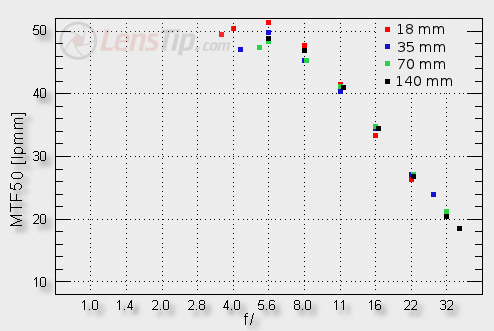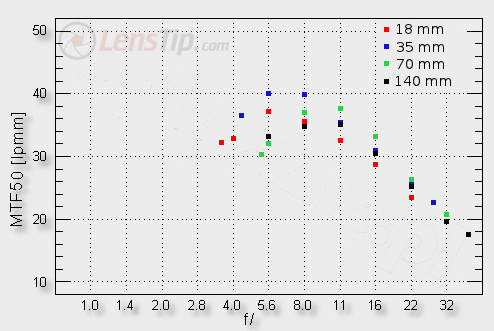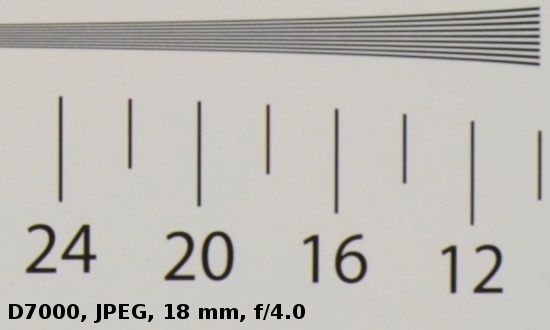Nikon Nikkor AF-S DX 18-140 mm f/3.5-5.6G ED VR
4. Image resolution
Let’s check how the tested Nikon fared in the frame centre – the appropriate values at the 18, 35, 70 and 140 mm focal lengths are presented on the graph shown below.

Please Support UsIf you enjoy our reviews and articles, and you want us to continue our work please, support our website by donating through PayPal. The funds are going to be used for paying our editorial team, renting servers, and equipping our testing studio; only that way we will be able to continue providing you interesting content for free. |
- - - - - - - - - - - - - - - - - - - - - - - - - - - - - - - - - - - - - - - - - - - - - - - -
Two things deserve a lot of praise. Firstly the lens’s performance is very even. Starting from f/5.6 aperture upward, no matter what focal length you employ, the MTFs remain very similar. Secondly the performance at the maximum relative aperture is simply impressive. Despite the high zoom multiple the lens has no problems whatsoever with generating sharp images when wide open. Mind you we don’t mean here that the lens is just slightly exceeding the decency level, quite the opposite in fact. At the weakest combination of 35 mm focal length and f/4.2 the MTF50 values reach 47 lpmm so way above 37-39 lpmm considered as decent by us.
The only thing that might worry you are the maximum results. Please, don’t understand me wrong – they are not bad, not at all. A level of 50-52 lpmm is perhaps not outstanding but certainly can be called very good. The problem is that the other rivals from the Nikon system, like the very well done Nikkor 18-105 mm VR, can show something better. We tested that one on the Nikon D200 and it was able to reach about 47 lpmm at best. The best fixed-focal lenses went to 47-49 lpmm as well so such a simple and cheap zoom could come near their best performance. We expected the same from the more expensive Nikkor 18-140 mm VR. Perhaps we were too demanding. After all we deal here with a wider focal range and a much more even performance. The Nikkor 18-105 mm fared exceedingly well in the 18-30 mm range but at the longer end the values it got were a bit inferior.
Let’s check the situation on the edge of the frame – the graph below will make the assessment of the tested lens’s possibilities easier.

It is normal that zoom lenses with such a zoom multiplier are always a result of a kind of compromise. Only at 35 mm focal length you can observe decent results, even at the maximum relative aperture. At other focal lengths the value at the maximum aperture is weak. On stopping down the lens the results hardly improve – even by f/8.0-f/11.o the MTFs don’t impress at all.
To sum up the Nikkor 18-140 mm VR surprised us nicely with its even and rather good performance in the frame centre; when it comes to the edge of the frame, it is just average, even if you compare it to the 18-105 mm VR model.
Traditionally we end this chapter presenting crops taken from our testing image in the frame centre. It’s worth remembering that those are JPEG files straight from the camera, saved along RAW files, described above.
 |






